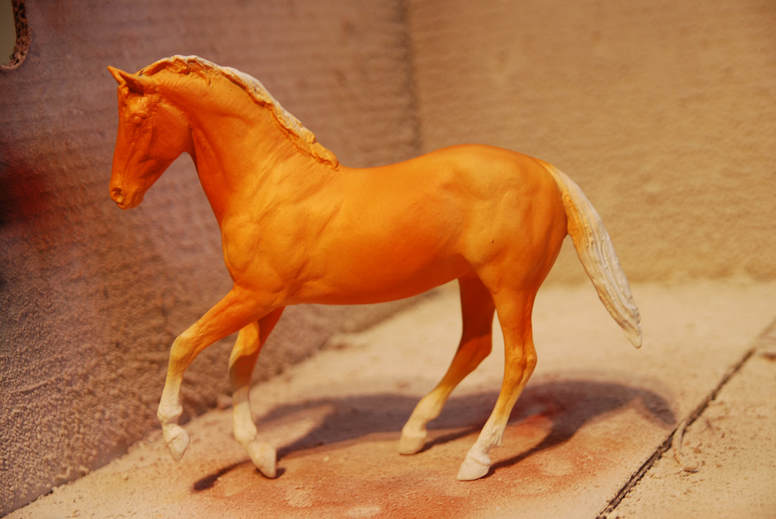The following tutorial was written in 2012.
The model used is a Breyer Classic Ginger.
The paints used were a mixture of vallejo, citadel and humbrol acrylics. Approximate costs are based on you buying all the items needed for this tutorial, it is assumed you will use hand painted acrylics for the costing although the horse was completed using an airbrush. This tutorial will also work for pastelling.
Difficulty Level: Medium
Approximate Cost: £40.00
The model used is a Breyer Classic Ginger.
The paints used were a mixture of vallejo, citadel and humbrol acrylics. Approximate costs are based on you buying all the items needed for this tutorial, it is assumed you will use hand painted acrylics for the costing although the horse was completed using an airbrush. This tutorial will also work for pastelling.
Difficulty Level: Medium
Approximate Cost: £40.00
Shopping List
Base Colour Paints
Pale Yellow
Ochre
Ginger
Dark Ginger
Black
Dark Brown
Detail Paint
Red
White
Tools
Paint Brushes
Optional: Airbrush/Pastel Brushes
Prepped Model Horse
Sealant
Gloss
Pale Yellow
Ochre
Ginger
Dark Ginger
Black
Dark Brown
Detail Paint
Red
White
Tools
Paint Brushes
Optional: Airbrush/Pastel Brushes
Prepped Model Horse
Sealant
Gloss
Base Colour
Step One
Add a layer of light yellow paint across the barrel of the horse and top of the legs (you can cover the whole horse if you wish).
Add a layer of light yellow paint across the barrel of the horse and top of the legs (you can cover the whole horse if you wish).
Step Two
Add a layer of ochre across the entire horse. Allow the base colour to show through on the stifle and elbow.
Add a layer of ochre across the entire horse. Allow the base colour to show through on the stifle and elbow.
Step Three
Use ginger paint on the barrel, head, neck, back and croup. Use reference to help see where you need to add shading. Also add some within the muscles and at the top of the legs.
Use ginger paint on the barrel, head, neck, back and croup. Use reference to help see where you need to add shading. Also add some within the muscles and at the top of the legs.
Step Four
Add dark ginger (if you don't have a dark ginger add a little bit of red brown to the same ginger paint you used in Step Three) to the head, top of the neck and belly.
Add dark ginger (if you don't have a dark ginger add a little bit of red brown to the same ginger paint you used in Step Three) to the head, top of the neck and belly.
Step Five
Mix together black with a small amount of dark brown. Now paint the horse's points (legs, tail, mane, muzzle, eyes and genitals).
Use some dark brown paint with a little bit of black to paint the dorsal stripe along the horse's back.
Mix together black with a small amount of dark brown. Now paint the horse's points (legs, tail, mane, muzzle, eyes and genitals).
Use some dark brown paint with a little bit of black to paint the dorsal stripe along the horse's back.
Step Six
Use some of the paint mix used in Step Five to add subtle leg barring to the horse's legs. You can add as much or as little as you like, look at reference to see how the stripes should look and how much you think would look realistic.
The horse's base colour is now complete. You can now add white markings and finish off the details such as the eyes and hooves.
Use some of the paint mix used in Step Five to add subtle leg barring to the horse's legs. You can add as much or as little as you like, look at reference to see how the stripes should look and how much you think would look realistic.
The horse's base colour is now complete. You can now add white markings and finish off the details such as the eyes and hooves.
The Details
Step One
Paint the eyes black
Paint the eyes black
Step Two
Mix some white with a little bit of red and paint the whole eye this colour.
Mix some white with a little bit of red and paint the whole eye this colour.
Step Three
Paint the iris in a dark brown. Now add an oblong shaped pupil in black.
Now paint your hooves using a dark grey for legs without white markings or a pale shell colour for those with white markings.
Paint the iris in a dark brown. Now add an oblong shaped pupil in black.
Now paint your hooves using a dark grey for legs without white markings or a pale shell colour for those with white markings.
Finishing Your Piece
Finish your model by sealing with a good quality sealant. Now gloss the eyes, nostrils and hooves.
If you have followed this tutorial we would love to see a picture of your completed piece. Email it to [email protected] and we will feature it in the gallery below.
If you have followed this tutorial we would love to see a picture of your completed piece. Email it to [email protected] and we will feature it in the gallery below.









